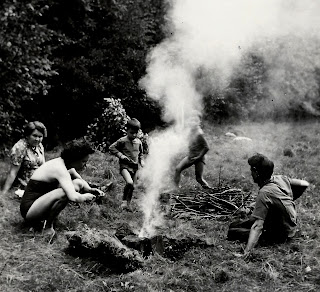Every picture tells a story, season 3, picture 16
During the first half of World War II, Peter the customs officer was lucky in that his work was deemed essential and he wasn't called up. Also, he was 39 years old at the start of the war, so not among the first to be considered. In 1939, he had been promoted and moved to Idar-Oberstein, just after the birth of his third (and last) daughter. We saw him with all three here.
In mid-1942, however, his luck ran out and he was called up as a Feldwebel (sergeant). At the beginning of October he was sent to the northern part of the Russian front, so I assume that's where these wintry photos were taken:
In his letters he mentions that he served as an adjutant (ie doing clerical work for the commander) which seems to fit with the letters "adj" above his head in the picture above. He also mentions they built a "villa" which could be the building shown.
During that winter, the battle of Stalingrad happened further south, so I guess it was relatively lucky still to be sent to the northern part of the front where events were less dramatic and large swamps limited the mobility of the opposing armies during the warmer seasons.
I only have like half a dozen photos of him in active service - thankfully none of them feature any weapons or military activity, so might share the other three (similar but no snow!) at some point too. Which will probably be the last we see of him.
Should anybody have any answers to some of the many questions I am raising in this series, please leave a comment here (I'll need to vet it, so it may take a few days before it goes public) or contact me at michaelgrr [at] yahoo [dot] co [dot] uk
Navigation tools:
Season 3 so far:
- family holiday
- play time
- fashion show
- bakery to butcher's shop
- the Hamborn brotherhood
- all grown up
- sisters in the snow
- the last holiday
- village life
- family reshuffle
- push bike
- mystery trio
- confirmands at Hamborn
- streets of Hamborn
- more grandchildren
- a Russian winter
The Mastodon thread for season 3 is here.
You can find Season 2 entries in this thread on Mastodon (complete now!) or via the list at the bottom of the last entry of the season (and also at the bottom of the first entry of this season).
The twitter thread for season 1 is still here. Alternatively, visit the last instalment and find the numbered list of entries at the bottom.



























